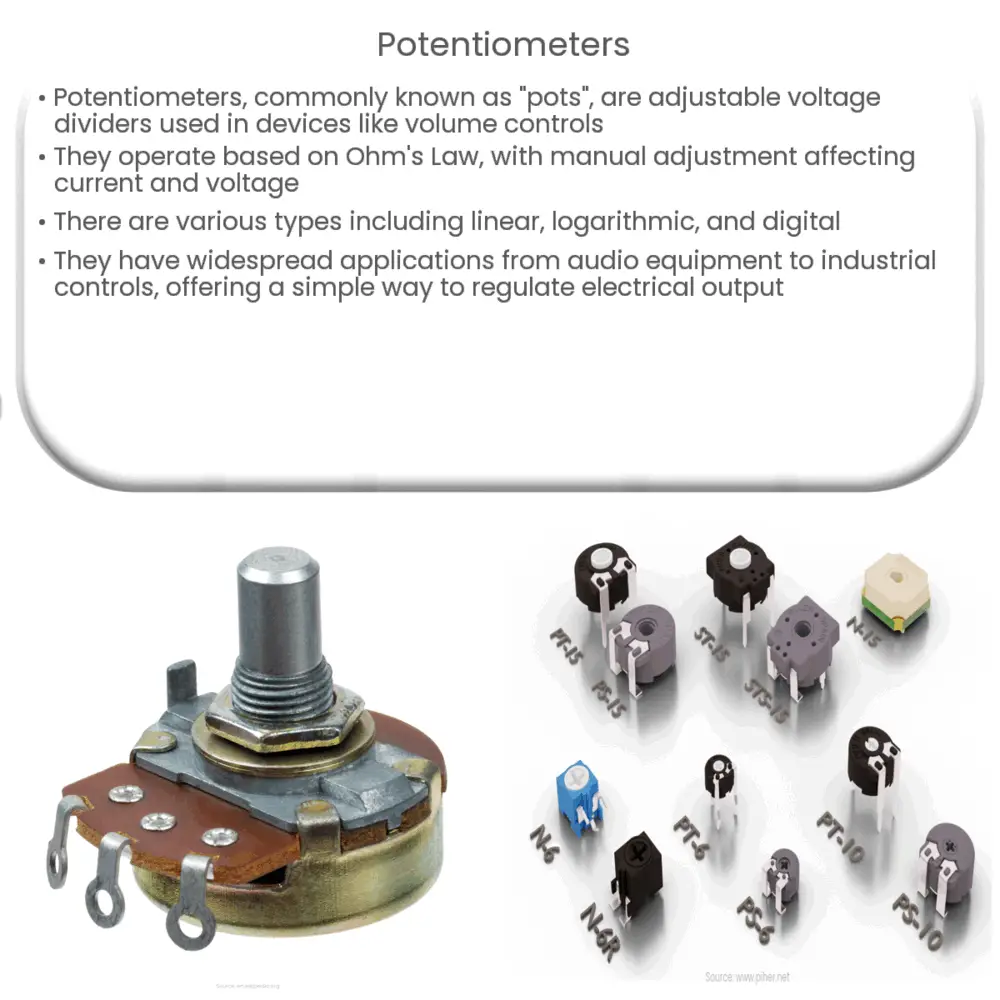Explore the world of potentiometers: their working principles, types, applications, pros and cons. Ideal guide for electronics enthusiasts.

Introduction to Potentiometers
A potentiometer, often referred to as a pot in electronic parlance, is a three-terminal resistor with a sliding contact that forms an adjustable voltage divider. Potentiometers are commonly used to control electrical devices such as volume controls on audio equipment. They operate by altering their resistance value, allowing for a variable output.
Principle and Working of Potentiometers
At its core, a potentiometer functions on the principle of Ohm’s Law, which states that the voltage across a resistor is directly proportional to the current flowing through it. The resistance of a potentiometer can be manually adjusted, which in turn adjusts the current and voltage. The three terminals of a potentiometer are referred to as the wiper (the adjustable contact that slides along the resistance element), and the two ends of the resistance element itself.
- The first terminal connects to the voltage source.
- The second terminal, or the wiper, connects to the output.
- The third terminal connects to the ground or the lower potential end of the voltage source.
Types of Potentiometers
There are numerous types of potentiometers, designed to serve various purposes. Here, we will discuss three of the most common types:
- Linear Potentiometers: Also known as linear taper potentiometers, these have a resistance element that distributes the resistive value evenly across the length of the track.
- Logarithmic Potentiometers: Also known as audio or log taper potentiometers, they distribute their resistive value following a logarithmic curve. These are most often used in audio applications.
- Digital Potentiometers: These are a type of potentiometer that can perform the same functions as a regular potentiometer but are controlled electronically rather than manually.
Each type of potentiometer has its unique applications and benefits, which will be discussed further in the next part of this article.
Applications of Potentiometers
Potentiometers have a broad range of applications across various industries and in consumer electronics. A few of these applications include:
- Volume Control: Potentiometers are often used in audio equipment, such as amplifiers and speakers, to regulate volume. They enable the user to adjust the volume by manually controlling the resistance, thereby controlling the output voltage to the speaker.
- Light Dimmers: In lighting systems, potentiometers can be used to adjust the brightness of lights. By changing the resistance, the current flowing to the light can be controlled, thus varying the brightness.
- Control Systems: Potentiometers are also used as position sensors in control systems. For instance, they can be used in joysticks for gaming or in knobs for industrial controls.
Potentiometers: Advantages and Disadvantages
Like any component, potentiometers have their pros and cons.
- Advantages: Potentiometers are simple, easy to use, and widely available. They provide a convenient means of varying resistance and controlling output in a circuit. They can also be used to measure voltage and to create time delays in circuits.
- Disadvantages: On the downside, mechanical potentiometers tend to wear out over time due to the physical movement of the wiper. They are also less precise than some other types of variable resistors, particularly at extreme settings. Digital potentiometers can overcome some of these disadvantages but may be more complex to implement.
Conclusion
In summary, potentiometers are an essential component in many electronic devices and systems, offering a simple and efficient way to control electrical output. Whether it’s adjusting the volume on your stereo, dimming the lights in your living room, or controlling complex industrial machinery, potentiometers play a key role. Despite some limitations, their advantages in terms of simplicity, versatility, and accessibility make them a mainstay in electronics. As technology advances, we expect to see further innovations in potentiometer design and application.

